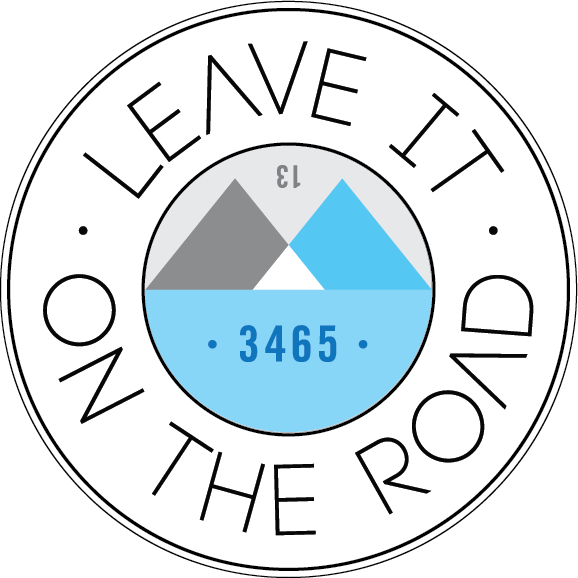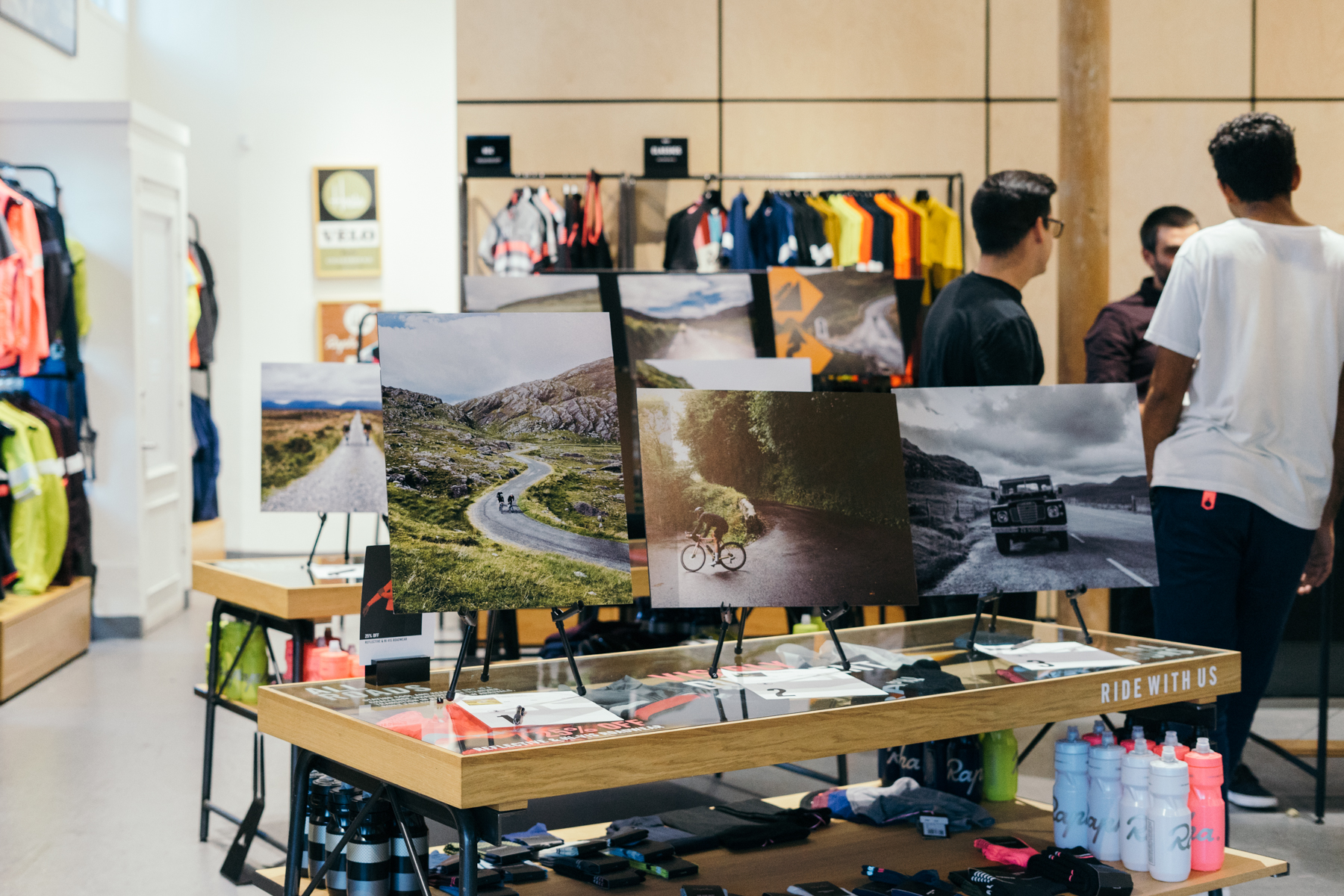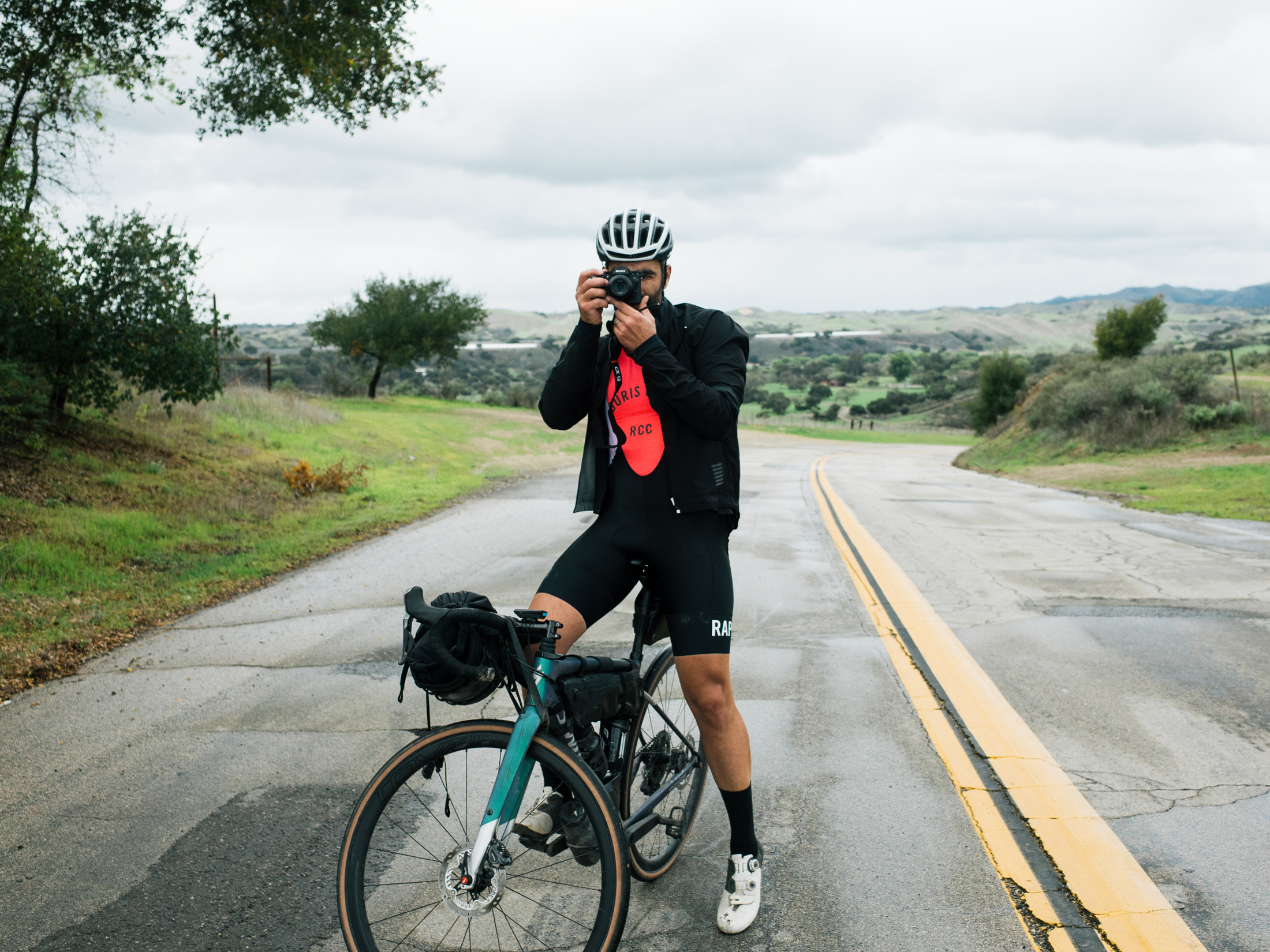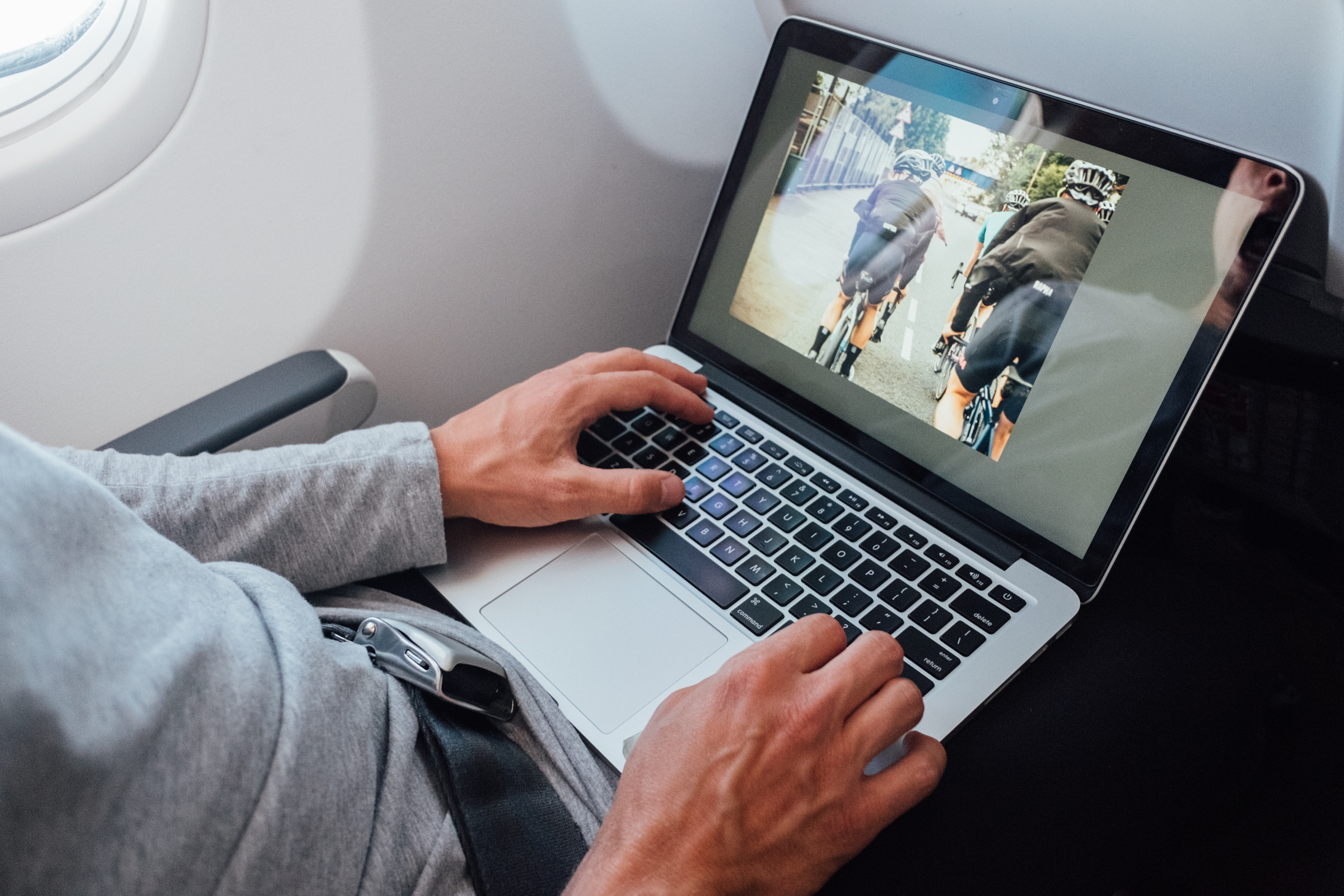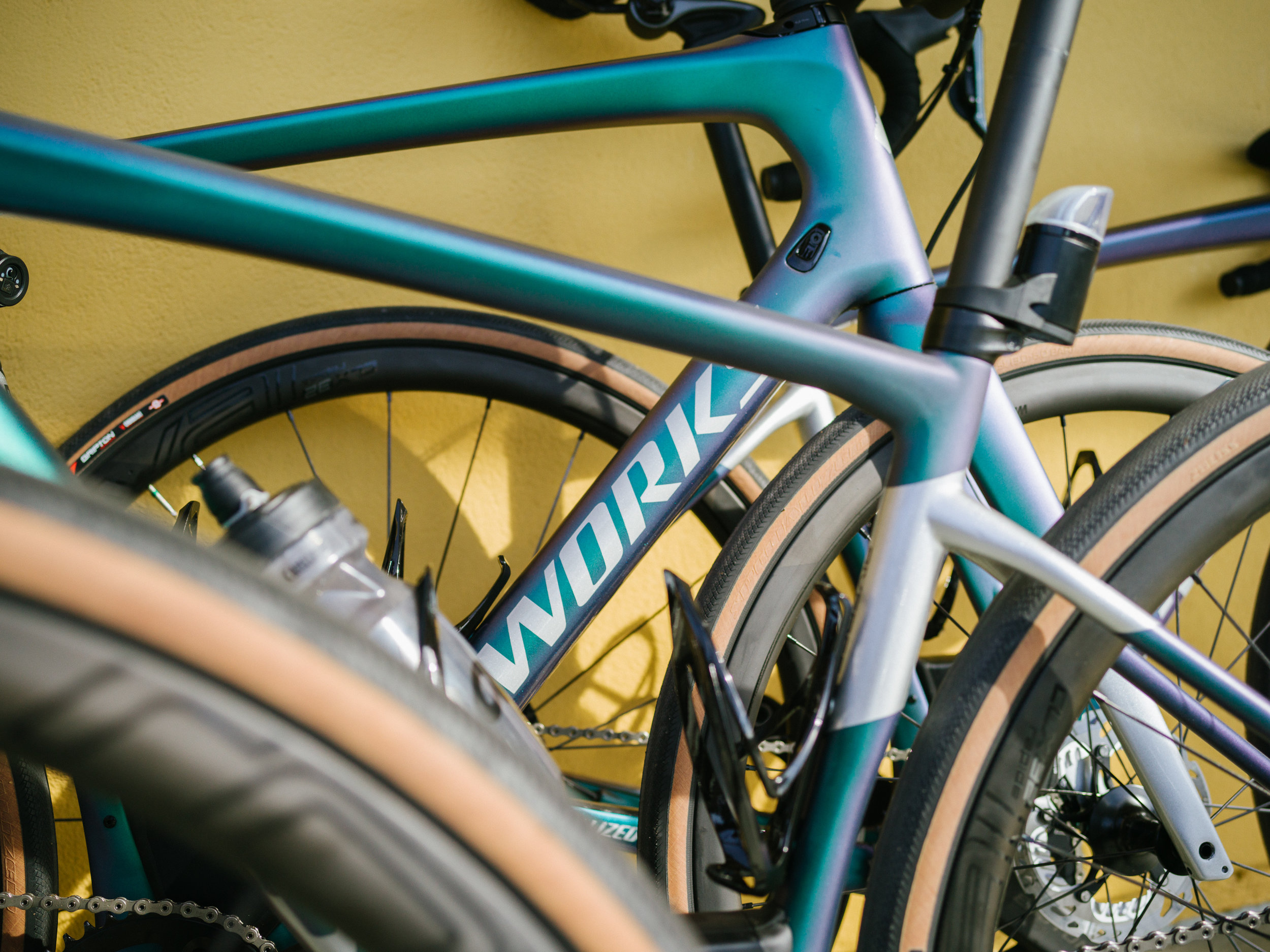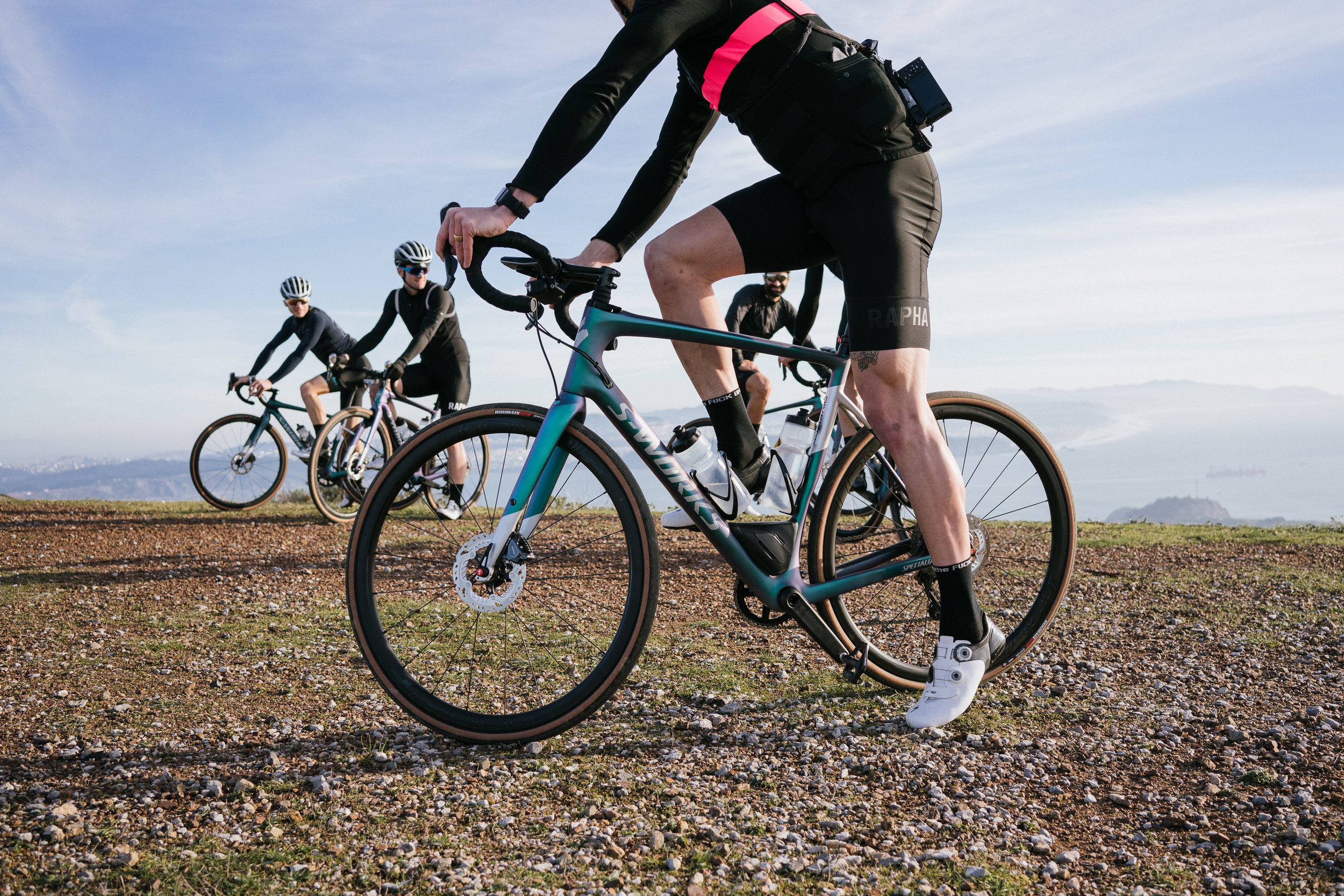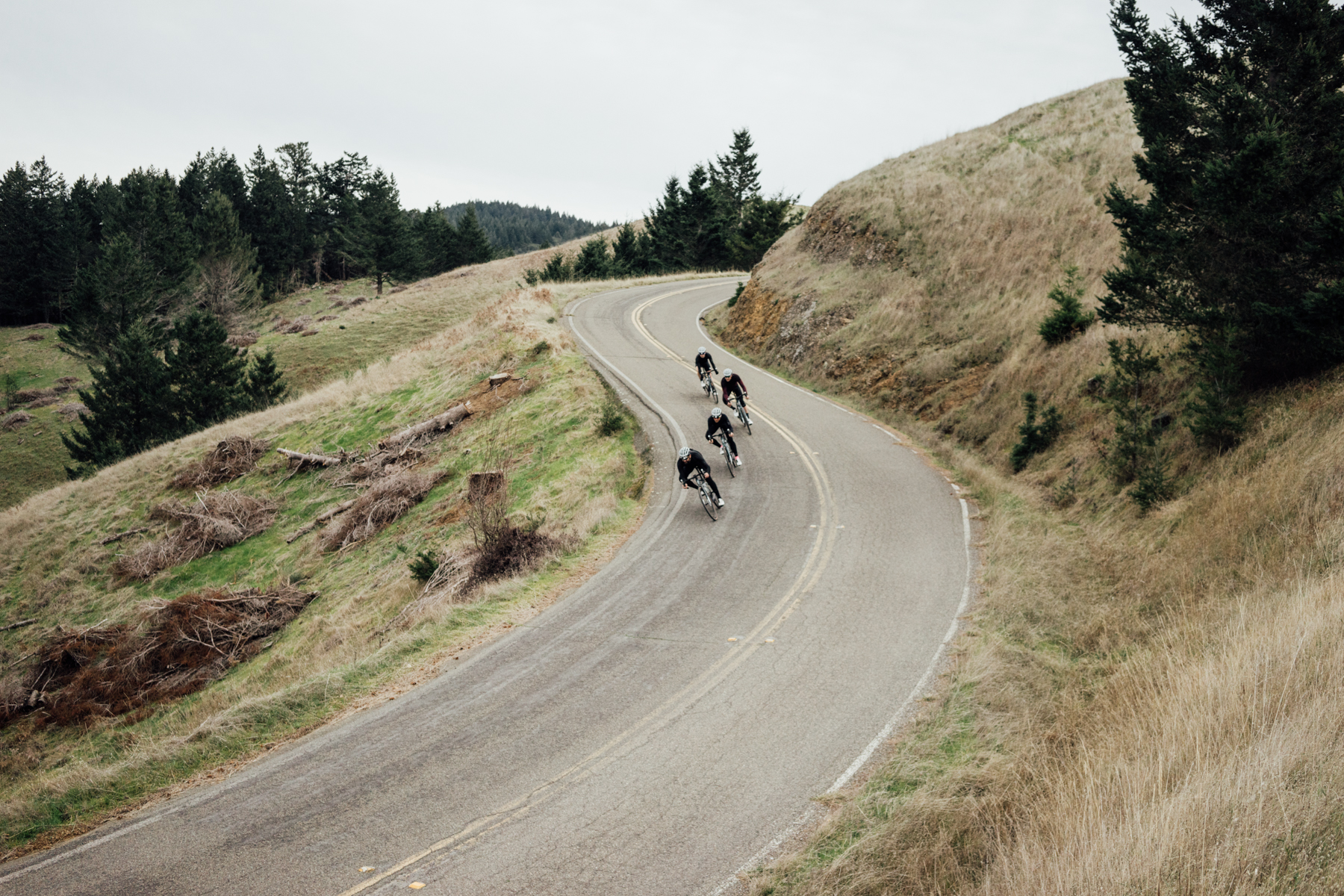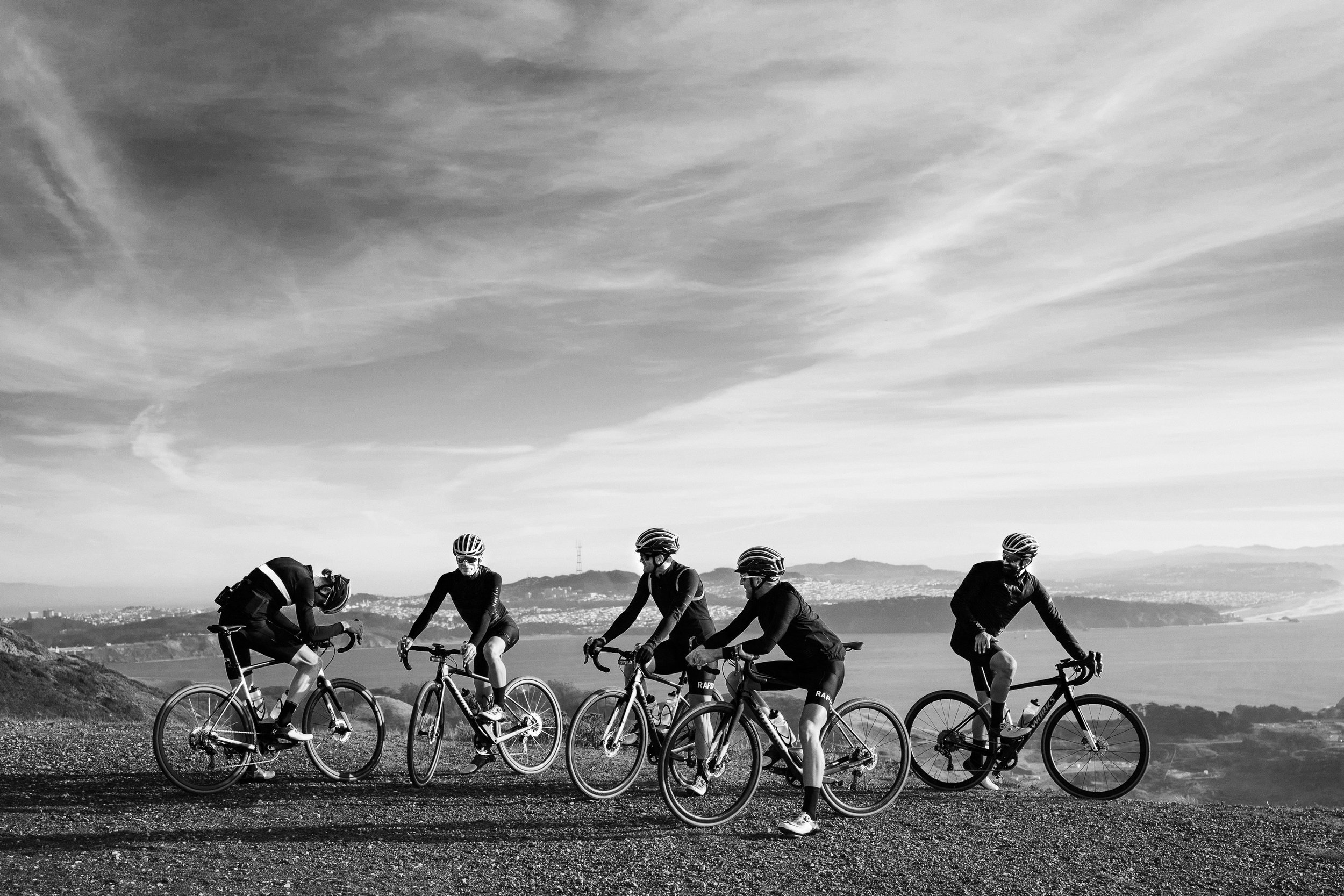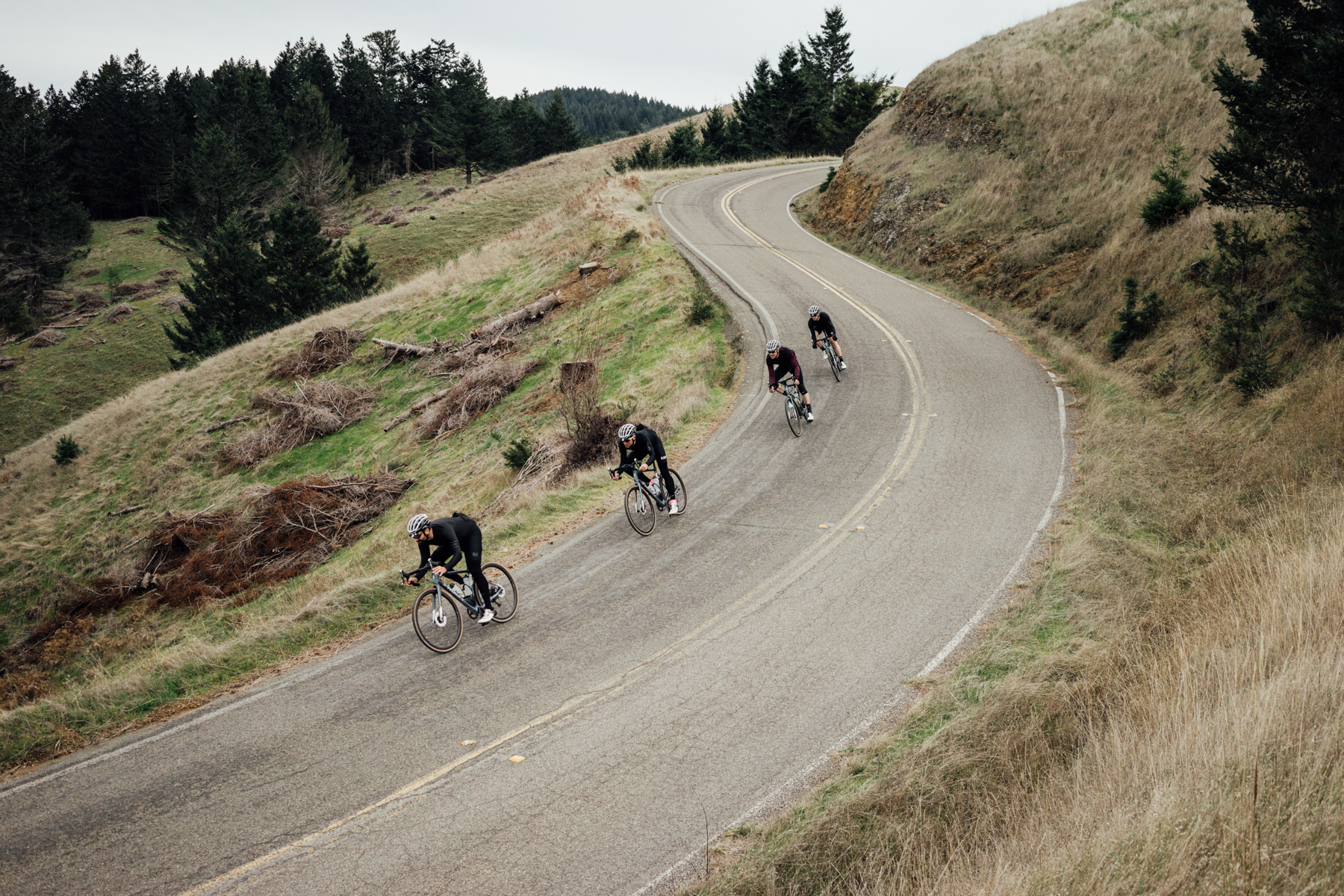Anthony Costa rides 3,100 miles in 31 days, self-supported to end cancer.
Our LIOTR Custom Specialized Womens S-Works Tarmac Disc Bikes
We’re obviously huge fans of Specialized and grateful for our five plus year partnership. In 2018 we starting riding Specialized S-Works bikes in addition to shoes, helmets and bottles, and they cooked up this special paint scheme in house with designer and painter Dylan Buffington. The colors represent the different cancers we’ve been affected by and raised money for. The components are top notch offerings from SRAM who provided a Red e-tap group. The Roval wheels and Specialized carbon components round out the package and the womens specific Mimic saddle is a huge plus as well. The Bolt cycle computer by our partner Wahoo is a must-have too. Ace photography via Jordan Clark Haggard.
Tips for planning and organizing a fundraiser bike ride – Q&A
Over the years, we've gotten many emails asking questions about how Leave It On The Road began. How do we plan rides? How do we fundraise and work with sponsors? It's sparked a lot of good conversation that we thought may inspire other groups and teams to join the fight against cancer. Here are some candid answers to our most often received questions:
LIOTR began as a fundraising-first cancer fighting cross-country ride.
Since day 1 we've always done things a little differently. We want to end cancer. We want to inspire and excite people to join the mission to end cancer, even if it isn’t our specific approach. We also really love riding bikes with excellent people to breathtaking places.
To do this right it’s important that the relationship across our mission, efforts and content connects with our donors, fans sponsors, and contributors. So, as content that can help others fight cancer and learn from what we do, here are all our candid answers to the questions we receive most often!
1. Planning & Logistics
How do you do route planning? What are your secrets?
We use a combination of Google and satellite view, Strava heat maps, and good old spreadsheets. There are no real secrets here other than a lot of detail work.
First we make a rough route via Google Maps to asses mileage and proximity to towns with Hotels. Then, we move to a first pass at getting it into Strava—looking for the roads we want to hit and total mileage. Finally, we'll break the complete route up into days based on where we can find hotels. This can be tricky, especially in remote areas where it's hard to find a hotel. Finally, we keep track of all of this in a spreadsheet like this:
How do you get home at the end of your rides? Do you rent a van, fly with your bikes, etc?
We've done a whole host of different things. For Ireland, we purposely made it a complete loop so we could leave our bike boxes at the same hotel we started at and fly home with them. Pro-tip, give yourself at least a full day in advance when flying with a bike – you never know when an airline may misplace a bike and you’ll have to scramble to find a replacement.
When we've done point-to-point rides, we've hauled bikes home in a support car from the trip, with some of the riders flying home and some driving in the car. The easiest way is to ship a bike box / case (with BikeFlights.com) to your last stop on the route so you have your case waiting for you.. Toting around a rental van full of bike boxes is not ideal. Often, we rent a car point-to-point so that no one has to drive back.
2. Fundraising
How you all have managed fundraising? Are your sponsors big contributors or does most of the fundraising coming from merchandise sales?
Most of our fundraising comes from the products we sell. A close second is when LIOTR riders’ employers match/double our own contributions. The company one of our riders works for has an incredible program that matches what we raise up to $15,000, so that really helps us increase what we can give to our chosen charity.
We put a strong emphasis on our visual content and storytelling. We’ve found that this is the best way to connect with our individual donors and social media fans. It also provides tremendous value to any corporations and brands who support LIOTR.
Cycling brands are usually happy to support you with gear if you can prove that you can help them generate content for their marketing. Monetary donations are a little more difficult here to organize, but they’re possible.
Specialized has stepped up in a big way to support us this year and we’re super thankful for that. In past years, Speedvagen did a custom paint job for us and donated an amount for every bike sold with the paint. Wahoo Fitness partnered with us in 2016 to donate a percentage of proceeds from sales of their ELEMNT computer, which was also very successful.
Do you have any other creative tactics for raising additional funds either through sponsors, pledges, anything creative, etc.?
Events such as Photo Shows and Group Rides with a fundraising raffle tend to work well. We select a space, arrange for coffee or beer, and food as donation, then promote an event for people to come see our photos, hear the story of our rides, and most recently, view our latest film. We ask our sponsors to donate products for a raffle at the event. We sell raffle tickets and raise money that way. We've found it takes a lot of personal time and energy to organize events like this, but it's worth it since we attract a good amount of donations through it.
3. Sponsorship
How do you involve sponsors for cycling equipment, nutrition, etc? You guys have a great list of partners. How'd you go about connecting with them, and how do you work together?
For us, this is all about the photography. We deliver photo packages for our partners in return for their sending us kit / gear.
Creating good photography that brands can utilize in their own communications saves them significant budget in comparison to putting their own shoot together. We guarantee certain brand sponsors a set of photos from the trip, along with the license / rights for marketing purposes. Essentially we use our expertise as content creators in order to deliver tangible marketing benefit to brands – which at times further elevates our social media presence – which in turn grows our ability to fundraise through the sale of merchandise and contributions.
We make a point of shooting content that they can use for their social media or blog and sometimes commit to a specific shot list that we deliver after the ride that doesn't even get posted to social. This is great because it gets us fresh gear for a demanding ride, but doesn’t always come with a monetary donation.
Our advice is to invest in a nice camera (the Ricoh GR is our long-time favorite) or find a friend who is a photographer that is willing to volunteer their time for the cause to photograph your ride and donate their photos to the sponsor brand. We often try to bring a dedicated photographer along for this and it goes a long way. If you can secure a photographer friend with a lot of followers on social, then bonus! That will help you grow your following too.
It took you guys some time to get to the point where you could get the sponsorships of such big companies so how did you get started?
We believe the success of our start was influenced by two factors:
In 2013, Michael’s epic ride across the country was carried by the support of friends at Rapha and Speedvagen and Tudor.
That first ride was timed perfectly with the rise of Instagram's popularity in the cycling community. Someone doing a big, crazy thing on a super cool bike, fully kitted in Rapha, professionally photographed hadn't really been done before on social media with that level of professional execution.
In 2015, Michael invited more friends along for the ride. We all happen to work professionally in the creative and marketing world, so growing our Instagram, doing great photography, and storytelling comes naturally to us. That said, we do put in a lot of time and energy behind the scenes to plan and execute each trip.
We hope our answers have been helpful! If you have other questions, please comment below. We're happy to help!
For more on our partnership with Specialized, check out this article →
In 2018 we ride with Specialized
We’re proud to announce that for 2018 Specialized will be fully supporting Leave It On The Road! After three years of providing with shoes and helmets, the folks at Specialized have become great partners, friends, and supporters of our mission to end cancer. We’re excited to work with Specialized to help us grow and extend our fundraising goals. We’re kicking the season off riding the Specialized S-Works Diverge, which perfectly suits the mix of early season weather and roads we experience in Portland and San Francisco. And most exciting of all, we’ll will be unveiling something very special later this year that we can’t wait to get working on. Stay tuned!
Our 2018 Planning Weekend
2018 is, for us, a year of focus and action. In the last four years we've raised just over $100k to help several cancer fighting organizations do great work in all areas of research, awareness and outreach. We're proud of our accomplishments, the journeys we've been on, the people we've met along the way, and the places we've seen that we wouldn't have otherwise. But still, we believe we can do more.
When you spend as much time on the bike as we do, you have plenty of time to let your mind wander and just enough training-inflicted self doubt to ask yourself a lot of hard questions. It was on one of those kinds of rides that we first started asking ourselves how we could have more impact and how we could grow this project and share it with even more people. What started in 2013 as a cross country ride designed to help me cope with my father's passing has evolved into something I am sure he would be proud of. Even still, we acknowledge that we have more to offer and we want to see just how far we can go towards ending cancer. To do that, we needed to move beyond being a bunch of friends who ride with a purpose, to a full-fledged organization with roles and responsibilities. So Michael, Patrick, Jake, Randall and David are now officially the operating board of LIOTR. In early January of 2018, this board met to set huge goals, mark milestones, plan routes, identify responsibilities and attack the year like we never have before. In the last four years we've raised just over $100k, this year we aim to take that even further.
Oh yeah, and we rode bikes too. Shiny new bikes. But more on that later...
The Big Lap video
For the first time on a LIOTR ride, we tackled shooting a film. And by "tackled" I mean, Randall shot the whole thing without anyone knowing. Seriously. Everyone thought he was taking pictures but he totally shot this beauty in secret. Two weeks ago we screened the film at a presentation at the Rapha Cycle Club in SF and now we're happy to share it with all of you. This definitely captures the spirit of our events, and the unique challenges of riding around Ireland. Enjoy.
A brush with colon cancer – Andrew's story
Andrew Hudon, cancer fighter, in his own words.
Sometime in January I started having unusual abdominal pain and discomfort. Luckily I've always had a pretty high pain threshold so I just ignored it the best I could and continued with my training. In the back of my head it nagged at me, as it was a similar story I had heard from so many colon cancer survivors, but I was too embarrassed to tell anyone, despite my familiarity with the disease and the advocacy work I had done. Then, Super Bowl weekend, I entered my first Nordic ski race, a 10k, and took second place. I rationalized to myself that there couldn't be anything wrong, I mean, I had just out skated people who had been doing this for years, my fitness must be through the roof, and how could I be sick with fitness like that? I pushed it to the back of my head and moved on and told no one, not even my wife.
But the pain continued. A few weeks later I was at work and had a bad bout of pain. I went to the bathroom and when I turned around to flush the toilet I was shocked to see it full of dark purple blood. Despite knowing, due to both my background in working with colon cancer and my career of developing medical devices used to treat it that dark purple meant bleeding from higher up in the GI tract, I again ignored it and told myself that it must just be a hemmorroid and nothing more than an annoyance. However, the pain continued, and soon the bleeding became an ever present issue. I made excuse after excuse to myself not to tell anyone. My birthday was March 1 and we went on a group ski trip. Why would I want to bring people down with this news? I had a lot going on at work, a trip to the doctor would be really inconvenient. There were other people out there with much worse problems, why should I burden them with mine? The excuses went on and on.
Finally one day toward the end of March, I realized I was not only being stupid and reckless, I was being a hypocrite. I had ridden over 7,000 miles and swam 37 in efforts to get people talking about colon cancer, and here I was ignoring symptoms and scared to tell anyone. I reached out to my friend Molly McMaster, a colon cancer survivor and the person who inspired me to start riding for colon cancer a decade before. She was concerned at my symptoms and wanted me to get in for a colonoscopy asap. It was a Friday afternoon. I got off the phone with her and called my doctor, who got me an appointment for Monday morning and told me to go to the emergency room if I started bleeding more over the weekend. I went home and told Kate. I wanted to tell her there was nothing to worry about when I saw the worry cross her face, but now I was scared. It was a long and restless weekend.
The doctor listened to my symptoms and kept a poker face. He inserted a scope in my rear end to look for obvious signs of bleeding that could rule out cancer. There were none. I understood why cancer survivors say the disease steals your dignity. He collected a stool sample to test. It came back saying I "may have colon cancer" but it could be wrong. I had to get a colonoscopy. I had to meet with the gastroenterologist beforehand. Again I had to describe my symptoms and again I saw the look of concern. She moved her schedule to get me in asap, and I started prep that night. If she was worried enough to move me to the top of her schedule, I figured I had reason to be worried too.
They say the worst part of a colonoscopy is the prep. They're right. It was 36 hours of discomfort and embarrassment. Not to mention keeping an endurance athlete from eating for that long. I played almost a full season of Madden on Wii to pass the time (pressing the pause button frequently and urgently to run to the bathroom). Finally it was time to go in for the scope.
I woke up in the recovery room with Kate there. We waited together for the doctor to come in with the results. They say a jury never looks at a defendant they have convicted when they walk in a court room. I wondered if doctors look at patients when they walk in the room with bad news. She walked in looking noticibly less concerned. Then she gave me the news: there were multiple polyps up to 6 cm. She was able to remove them all and none had gone through the colon wall, so if they came back from pathology benign then I would be in the clear, but even if they were malignant I would probably not need anything additional. I couldn't believe the sense of relief. I realized that for a few weeks I had only been thinking of my life in terms of a few days at a time, the future was too uncertain to consider. Now I was ready to jump back into training, work, and life. The next day I called a friend who was a very experienced colorectal surgeon specializing in colon cancer. He said I was very lucky, that if I'd gone much longer it likely would have been full on staged colon cancer.
I began thinking about the work I had done on the bike for colon cancer. Aside from my knee, I was stronger and more fit than ever. I hadn't been doing the volume or specialization of training needed for an ultra ride, but my knee was doing better and better and I wondered if maybe I could do another ride. This time it would have even more purpose. I would still be riding for all the cancer patients and survivors I had ridden for in the past, but this time it would be about more, it would be about redemption. So now I'm back to training, on and off the bike. I'm getting stronger. I'm starting to believe again. I'm starting to tell myself I can do this. But I have to be smart. I've selected boulder to San Francisco as my ride. I'll need to do about 160 a day for 8 days. I'm getting there. In October I'll make a decision. In the meantime I will cheer mike on and ride vicariously through him and his crew. Perhaps I'll even get out there for a big mileage day to ride with them in spirit. And then perhaps, just perhaps, a year from now I will once again head out there to leave it on the road.
Seven Sisters with MG
Every now and then you do one of those rides that is just better left described in images.
Announcing the Leave It On The Road Mixtape ride!
Presented by Adventure Wagon. Sponsored by Speedvagen, Rapha & Wahoo Fitness
What is the bike ride equivalent of a mixtape? Some of you may be old enough to remember the hours put into crafting a cassette with two perfect sides. Do you start with a banger or do you ease on in and blow it out later? Is the mix full of hits or are you digging for those unknown gems that simply must be shared? How do you transition from Side A to Side B? The countless decisions and directions and planning and curating and recording and erasing and recording again. The consequences you face if you make a wrong decision. The pride you feel when you've fucking nailed it and you have a perfect mixtape that you listen to again and again and again. And of course, the whole time you have a person in your mind that the mixtape is dedicated to. Swap music for roads and you can see where we are going with this. One more adventure to fight cancer begins next Saturday 8/27. You're going to want to listen in to this one.
All donations and proceeds from sales benefit the Colon Cancer Alliance.
Side A Track 1: 96 miles, Continental Divide, 8/27/16
Side A Track 2: 121 miles, Craters of the Moon, 8/28/16
Side A Track 3: 98 miles, Oregon Trail, 8/29/16
Side A Track 4: 110 miles, Off That Grid, 8/30/16
Side A Track 5: 100 miles, John Day, 8/31/16
Side A Track 6: 94 miles, Painted Hills, 9/1/16
Side A Track 7: 95 miles, Mt Hood / PDX, 9/2/16
BONUS TRACK: PDX Group ride & party at The Vanilla Workshop, 9/3/16
Side B Track 1: ??? 9/4/16
Side B Track 2: ??? 9/5/16
Side B Track 3: ??? 9/6/16
Side B Track 4: ??? 9/7/16
Side B Track 5: ??? 9/8/16
Side B Track 6: ??? 9/9/16
Side B Track 7: ??? 9/10/16
Side B Track 8: ??? 9/11/16
